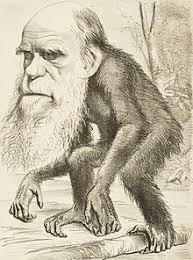Why was the so-called “idiot” population of Victorian Britain so important to Charles Darwin’s theory of evolution? Simon Jarrett looks back at a little-known aspect of his work that aimed to show there were close links between humans and animals
When Charles Darwin published On the Origin of Species by Means of Natural Selection in 1859, it is no exaggeration to say that he changed how we view the world.
He demonstrated that animal and plant species had slowly evolved over millions of years by a process known as natural selection, in which they adapted to their environment in order to survive.
Human beings and other animals had all begun as single-cell organisms in sludgy swamps, eventually becoming those marvellously sophisticated and complex organisms we are today.
This theory of evolution threw the world into disarray. It became difficult to maintain that human beings were specially created by God 5,000 years ago, as believed by those who interpreted the bible literally. The world was far older; human beings were much less special and of humbler origin than people had believed.
Many questions arose about human origins, and some were to have important implications for people with learning disabilities.
First, if humans and other animals evolved physically, they must also have evolved mentally. The human mind must have moved to full consciousness from a state of nothingness. How did this happen?
Second, if some human and animal species had the same origin, and if some animals evolved into humans, could we detect similar behaviours and mental activity across species to prove these connections?
“Lower” form of life
Darwin took a particular interest in those he called “idiots”, using the language of his time. He saw them as a “lower” form of human life; therefore, if he could show striking similarities between them and the “higher” animals, this would be evidence of the evolutionary process.
His aim was to narrow the consciousness gap between humans and animals, to prove that, while humans had developed into the most complex and sophisticated of all animals, they were far closer to animals both mentally and physically than people had been prepared to acknowledge. So-called idiots were, for Darwin, an excellent way of demonstrating this.
After Origin of Species, he published two books, The Descent of Man (1871) and The Expression of the Emotions in Man and Animals (1872). In both, he tackled the subject of human evolution.
In The Expression of the Emotions, he described joy and high spirits, which he saw as instinctive reactions across species to pleasurable feelings. He gave examples of “idiots” for whom laughter was the most prevalent emotional expression. This could not, he argued, be attributed to them having “distinct ideas” – they were just instinctive expressions of pleasure.
In The Descent of Man, he described what he believed to be the animal-like characteristics and habits of “idiots”, some of whom were “remarkably hairy”, lacked speech, ascended stairs on all fours, climbed trees, smelt their food before eating it or made grimaces. He compared those who were “continually gambolling and jumping about” with lambs who “delight to frisk on any hillock”.
These observations all supported Darwin’s emerging theory of how the mind evolved.
Intelligent life began with reflex actions, with no conscious thought or intention. Reflexes then developed into instincts, which involved a small element of consciousness, and were passed from generation to generation within species. Instinct then evolved into conscious action, in which animals, human or otherwise, could make choices as their minds developed memory and understanding.
Humans had the most highly developed consciousness of all, which is why reflex and instinctive actions were far less visible in them than in other species. Nevertheless, as observations of idiots, small children and higher animals showed, humans were built on reflex and instinct just like all the other species. Idiots were largely instinctive and reflexive, while “normal” infants developed into fully conscious humans.
Darwin’s theory gave rise to a new discipline of animal (or comparative) psychology. Practitioners observed animal behaviour and compared it that of to human infants and “idiots” to try to understand how the mind developed.
It was at around this time that the idea of “mental age” became important in psychology. Chimps could perform at the level of a four-year-old child when given tasks to do in experiments, seen as greatly to their credit. Adult idiots also performed at a similar level, much to their detriment.
This thinking persists today. Many books claim that apes, monkeys, dogs, cats, birds, cows and even fish are very similar in their mental lives to humans, and are conscious, intelligent and emotional beings.
Lurking beneath this school of thought lies Darwin’s quest to narrow the gap between the human and animal to prove evolutionary theory. A key element of that quest was to exaggerate the incapacities, inabilities and animal-like qualities of those he called idiots, to prove the animal-human link.
Darwin C (1859/1998) On the Origin of Species by Means of Natural Selection. Ware: Wordsworth Editions
Darwin C (1871/ 2004) The Descent of Man and Selection in Relation to Sex. London: Penguin
Darwin C (1872/ 2009) The Expression of the Emotions in Man and Animals. London: Penguin






